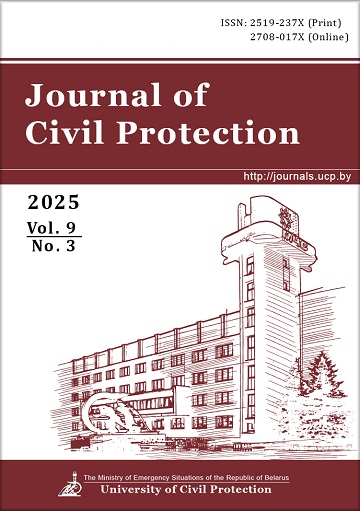Detectors of ionizing radiation on the base of waveguide ring resonators with hyperlinked fluoropolymer
DOI:
https://doi.org/10.33408/2519-237X.2025.9-3.300Keywords:
microring resonator, slot waveguide, hyperlinked fluoropolymer, detector of ionizing radiationAbstract
Purpose. Optimization of the parameters of waveguide microring resonators in order to achieve the maximal sensitivity of optical detectors of ionizing radiation.
Methods. Methods of numerical calculation of the field distribution and effective index of the mode of bent slot waveguides, algorithms of calculation on the base of the method of lines.
Findings. The structure and operation principles of optical detector of ionizing radiation are presented. The sensor element of the detector is the microring resonator based on the slot waveguide filled with hyperlinked fluoropolymer. The optimization of the slot waveguide parameters in order to achieve the maximal detector sensitivity has been carried out. It is shown that the sensitivity of the detector on the base of microring resonator from double slot waveguides with optimized parameters and resonator radius equal to 67.8 μm could be as high as 103.5 μA/kGy at measuring range equal to 85 kGy and detector resolution equal to 0.2 Gy.
Application field of research. The results of review and analysis of the information about the methods of measurement of absorbed dose of ionizing radiation can serve as a basis for creating effective optical waveguide dosimeters with high sensitivity.
References
Friebele E.J., Griscom D.L., Sigel G.H. Defect centers in a germanium-doped silica core optical fiber. Journal of Applied Physics, 1974. Vol. 45, No. 8. Pp. 3421–3428. DOI: https://doi.org/10.1063/1.1663795.
Friebele E.J., Gingerich M.E., Long K.J. Radiation damage of optical fiber waveguides at long wavelengths. Applied Optics, 1982. Vol. 21, No. 3. Pp. 547–553. DOI: https://doi.org/10.1364/AO.21.000547.
Kase K.R., Bjärngard B.E., Attix F.H. The dosimetry of ionizing radiation. New York: Academic Press, 1987. Vol. 2. 384 p. DOI: https://doi.org/10.1016/C2013-0-10940-3.
Andreo P., Burns D.Т., Nahum A.E., Seuntjens J., Attix F.H. Fundamentals of ionizing radiation dosimetry. Weinheim: Wiley-VCH, 2017. 857 p. ISBN 978-3-527-40921-1.
Rana S., Subbaraman H., Fleming A., Kandadai N. Numerical analysis of radiation effects on fiber optic sensors. Sensors, 2021. Vol. 21, No. 12. Pp. 4111–4127. DOI: https://doi.org/10.3390/s21124111.
Summers G.P., Burke E.A., Shapiro P., Messenger S.R., Walters R.J. Damage correlations in semiconductors exposed to gamma, electron and proton radiations. IEEE Transactions on Nuclear Science, 1993. Vol. 40, No. 6. Pp. 1372– 1379. DOI: https://doi.org/10.1109/23.273529.
Johnston A.H. Radiation effects in optoelectronic device. IEEE Transactions on Nuclear Science, 2013. Vol. 60, No. 3. Pp. 2054–2073. DOI: https://doi.org/10.1109/TNS.2013.2259504.
West R.H., Dowling S. Effects related to dose deposition profiles in integrated optics structures. IEEE Transactions on Nuclear Science, 1996. Vol. 43, No. 3. Pp. 1044–1049. DOI: https://doi.org/10.1109/radecs.1995.509831.
Girard S., Baggio J., Bisutti J. 14-MeV neutron, γ-ray, and pulsed X-ray radiation-induced effects on multimode silica-based optical fibers. IEEE Transactions on Nuclear Science, 2006. Vol. 53, No. 6. Pp. 3750–3757. DOI: https://doi.org/10.1109/TNS.2006.886222.
Berghmans F., Brichard B., Fernandez A.F., Gusarov A., Uffelen M.V., Girard S. An introduction to radiation effects on optical components and fiber optic sensors. In: Optical Waveguide Sensing and Imaging. NATO Science for Peace and Security Series. Springer, Netherlands, 2008. Pp. 127–165. DOI: https://doi.org/10.1007/978-1-4020-6952-9_6.
Goncharenko I.A., Il'yushonok A.V., Ryabtsev V.N. Izmerenie pogloshchennoy dozy ioniziruyushchego izlucheniya s pomoshch'yu opticheskikh volnovodnykh kol'tsevykh rezonatorov [Measurement of absorbed dose of ionizing radiation by means of optical waveguide ring resonators]. Journal of Civil Protection, 2023. Vol. 7, No. 1. Pp. 5–12. (rus). DOI: https://doi.org/10.33408/2519-237X.2023.7-1.5. EDN: https://elibrary.ru/ATBOQQ.
Grillanda S., Singh V., Raghunathan V., Morichetti F., Melloni A., Kimerling L., Agarwal A.M. Gamma radiation effects on silicon photonic waveguides. Optics Letters, 2016. Vol. 41, No. 13. Pp. 3053–3056. DOI: https://doi.org/10.1364/OL.41.003053.
Pregla R. The method of lines for the analysis of dielectric waveguide bends. Journal of Lightwave Technology, 1996. Vol. 14, No. 4. Pp. 634–639. DOI: https://doi.org/10.1109/50.491403.
Goncharenko I.A., Helfert S.F., Pregla R. Radiation loss and mode field distribution in curved holey fibers. AEU – International Journal of Electronics and Communications, 2005. Vol. 59, No. 3. Pp. 185–191. DOI: https://doi.org/10.1016/j.aeue.2004.11.012.
Goncharenko I., Marciniak M., Reabtsev V. Electric field sensing with liquid-crystal-filled slot waveguide microring resonators. Applied Optics, 2017. Vol. 56, No. 27. Pp. 7629–7635. DOI: https://doi.org/10.1364/AO.56.007629.
Karnutsch C., Smith C.L.C., Graham A., Tomljenovic-Hanic S., McPhedran R., Eggleton B.J. [et al.]. Temperature stabilization of optofluidic photonic crystal cavities. Applied Physics Letters, 2009. Vol. 94, No. 23. Article 231114. 3 p. DOI: https://doi.org/10.1063/1.3152998.
Zhao Y., Zhang Y.-N., Lv R.-Q., Li J. Electric field sensor based on photonic crystal cavity with liquid crystal infiltration. Journal of Lightwave Technology, 2017. Vol. 35, No. 16. Pp. 3440–3446. DOI: https://doi.org/10.1109/JLT.2016.2576500.
Published
How to Cite
License
Copyright (c) 2025 Goncharenko I.A., Il'yushonok A.V., Marciniak M., Ryabtsev V.N.

This work is licensed under a Creative Commons Attribution-NonCommercial 4.0 International License.




















